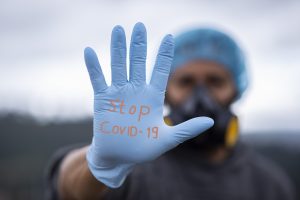Le "Eye Pills - COVID-19'. are dedicated to scientific articles, which deal with ocular symptoms or complications of SARS-CoV-2 infection or behaviour and rules that have implications for eye health and wellbeing.
We open this series of 'Eye Pills' with a review that confirms the importance of preventive measures and emphasises the need to adequately protect eyesvaccination campaigns aimed at immunising the majority of the world's population against COVID-19 have begun.
Physical distancing, face masks, and eye protection to prevent person-to-person transmission of SARS-CoV-2 and COVID-19: a systematic review and meta-analysis
Derek K Chu , et al , COVID-19 Systematic Urgent Review Group Effort (SURGE) study authors
Lancet. 2020 Jun 27;395(10242):1973-1987.
This in-depth and systematic meta-analysis, published in the journal Lancet, starts with clinical evidence: SARS-CoV-2 (Severe Acute Respiratory Syndrome Coronavirus 2), which causes COVID-19, spreads from person to person via close contacts.
 The aim of the review is to establish what is the optimal distance to prevent virus transmission and to verify to what extent thecombined use by facial masks e goggles is useful in terms of prevention.
The aim of the review is to establish what is the optimal distance to prevent virus transmission and to verify to what extent thecombined use by facial masks e goggles is useful in terms of prevention.
The meta-analysis, financed by the World Health Organisation (WHO), differs from previous studies in that it examines only systematic data and not partial findings, and refers exclusively to epidemic and pandemic phenomena (i.e., not seasonal flu), such as COVID-19, but also SARS and MERS, and finally provides indications for both healthcare and non-healthcare settings (home, work, etc.).
The conclusions of the research confirm three indispensable indications to contain the spread of the infection:
- Physical distance to not less than 1 metre. In order to further reduce the risk, higher interpersonal distances of around 2 m might be desirable (not always implementable).
- Systematic use of facial masks, ranging from surgical masks, to 12-16 layer cotton or gauze masks, to N95 filtering facial respirators.
- Combined use of appropriate eye protection (goggles or visors).
These 'protection strategies' are strongly recommended in health care settings, but also in non-health care settings, both public and private.
The review also reports a number of discomforts related to the prolonged use of protective devices, such as discomfort and erosions of the facial skin, difficulties in verbal communication and marked reduction in empathy between caregivers or family members and COVID patients.
The article is available in full through this link.
Good reading
You might also be interested in COVID-19 Eye Pills:
Dr. Carmelo Chines
Direttore responsabile
